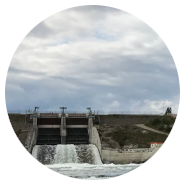Motivation, Goals and Benefits
In 1954, functional completion of the Kenney Dam led to the formation of the Nechako or Ootsa Reservoir, from which water is diverted through a 16 km tunnel to the Kemano hydropower generating station. These facilities are managed by Rio Tinto, primarily to support its aluminum smelter at the coastal community of Kitimat. Recent modernization of this plant, together with increasing demand for renewable sources of energy, have demonstrated an urgent need to improve understanding of how changing climatic conditions, together with water-management operations of this type, may be influencing water security in the Nechako and other comparable watersheds.
The principal goals of the NRT-IRC in Climate Change and Water Security are therefore as follows:
-
To improve monitoring and assessment of changing weather patterns in the Nechako watershed, with particular emphasis on seasonal snowpack evolution;
- To determine how these influences are altering volumes, distributions and timings of water within the vast network of streams, rivers, wetlands and lakes which form the Nechako drainage, thereby impacting water security across the watershed as a whole.
Our research spans the exploration of a wide range of meteorological and hydrological phenomena, and broad consideration of their consequences for water supplies.
For example, we are assessing how climate change is affecting the strength and frequency of atmospheric river events - the so-called 'Pineapple Express' storms - and the heavy precipitation they bring to the Coast Mountains and Interior Plateau.
We are also conducting modelling studies, tracking historical trends in river flows and water temperatures, and incorporating the roles of climate change and reservoir operations to improve predictions of how these may develop in the future across the Nechako watershed.
This new knowledge will provide vital details about changing water supply and temperatures, informing assessment of implications relating not only to the provision of human water resources, but also to the survival of keystone fish species such as trout, salmon and white sturgeon.
Our research is fostering close interactions between stakeholders throughout the Nechako watershed, including local communities and First Nations, Rio Tinto and other industries, and non-governmental organizations.
It is also providing unique training experiences for 13 university students and researchers, preparing them for future employment opportunities in all sectors.
Ultimately, our findings will guide Rio Tinto's future management of the Nechako reservoir, ensuring both socio-economic and environmental benefits across the region.







